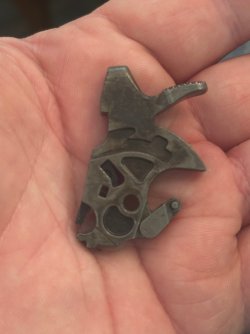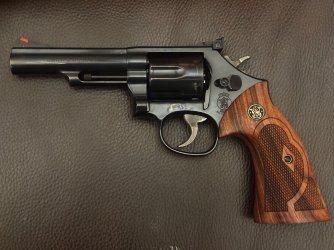- Joined
- May 20, 2025
- Messages
- 223
- Reaction score
- 455
I think some are confusing the new drop safety device with the internal lock. The new drop safety is not a replacement for the internal hammer lock; it is not a "neutered" version of the hammer lock. They are intended for entirely different purposes and function differently. The internal hammer lock is a storage device intended to make the gun inoperable until unlocked with a key. The new drop safety just happens to be located in the same place as the internal lock, but it isn't a substitute for it. Since S&W wasn't going to have different hammers MIM'ed for the internal lock vs "no lock" versions of the same guns, they cleverly adapted the new drop safety to make use of the existing lock lug raceway and notches that the internal lock uses. In doing so, it avoided them having to change the geometry of the hammer sear ledge to prevent forceable push-off if dropped on the hammer or add some other more complex device elsewhere in the action. In this way, it simplifies production and doesn't necessitate a whole host of different parts to inventory for the IL vs "no lock" guns.
There was already room inside the frame where the IL used to be for the drop safety, as well as a means of engaging the hammer already molded into the existing hammers being used. Again, the new inertial drop safety and the IL are not analogous. The IL is intended as a safeguard against unauthorized use of the guns and is not pertinent to the drop test requirements in CA and other states.
I agree that the idea of incorporating new safeties inside the gun in principle feels like capitulating to politics and are insulting to intelligence, but in this case, the new device is entirely hidden on the inside, doesn't require the slot be cut out of the frame beside the hammer, and doesn't interfere with function or feel of the action in any way in normal everyday use. I therefore saw no reason to remove it from my M19-10. I do lament the fact that if it weren't there, the previous, sexier frame contour could return, but there's nothing I can do about that.
There was already room inside the frame where the IL used to be for the drop safety, as well as a means of engaging the hammer already molded into the existing hammers being used. Again, the new inertial drop safety and the IL are not analogous. The IL is intended as a safeguard against unauthorized use of the guns and is not pertinent to the drop test requirements in CA and other states.
I agree that the idea of incorporating new safeties inside the gun in principle feels like capitulating to politics and are insulting to intelligence, but in this case, the new device is entirely hidden on the inside, doesn't require the slot be cut out of the frame beside the hammer, and doesn't interfere with function or feel of the action in any way in normal everyday use. I therefore saw no reason to remove it from my M19-10. I do lament the fact that if it weren't there, the previous, sexier frame contour could return, but there's nothing I can do about that.






